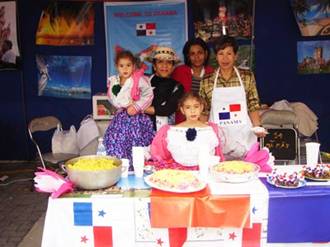Club of multinational women
Differences
From a group of 30 ladies of diplomats in
“We live in the community of Vietnamese but we don’t completely belong to it,” said Angela Frozik-Seppala, a German member said.
The club is a special cultural space, which has the mixture of cultural characteristics from 56 countries. English is the major language used at the club but “each member speaks in a different way”.
“I can’t differentiate that she is speaking in English or Japanese. I have to request her to repeat all the time,” a club member talked about another Japanese member. “We often use body language to express our ideas,” one said.
The difference in thinking is more difficult, they said. A German member, Angela, and Thea Frisby, a Dutch, believed that all Asian people think in the same way. But joining this club, they have changed their prejudice. They are pleased to see that Vietnamese people are different from Chinese, Indonesian or Malaysian.
“Firstly, when others said ‘yes’ to me, I thought that they agreed with me, but now I now that ‘yes’ is simply, ‘I’m listening’,” said Thea Frisby.
Angela said that one could learn many interesting things from this club. For example, Indonesians and Japanese are very polite. They always say ‘yes’ and never argue with you and you can’t understand whether they agree or don’t agree with you. Meanwhile, people from some other countries are very outspoken. They are ready to say, “I don’t agree with this point”.
“There are misunderstandings and debates but we are friends anyways,” said three women, one from
“Solving problems and surpassing differences to cooperate together is an interesting and funny part of life,” said Luyen Shell, a Vietnamese American.
“Through each debate, our mind is more open and we are ready to learn from each other,” said Thea Frisby. “We select this life, this club ourselves to create a special cultural space, to meet, to exchange and to feel comfortable. We internationalise our thinking and lifestyle,” she added.
Bridges of culture
And those women are bridges of culture. The deepest impression about them is their warm smiles. The club often organises Newcomer’s Coffee Morning to welcome new members. There they learn together about the culture and tradition of the country of the newcomers, which is called “Meet My Country”.
Last December, Mrs Luyen Shell represented
Meeting members of the International Women’s Club at the house of Mrs Luyen Shell, who left
In combination with the Vietnam Women’s
At ‘small’ meetings, they teach each other how to cook special cuisines of their countries and how to make gifts from simple materials.
Mrs Luyen Shell said that foreign women are fond of learning embroidery of
The meeting of hearts 
Activities of the International Women’s Club like the annual charity fairs have erased the distance of social positions. The fair is a chance for each country to introduce their specialties. From children to diplomats, even ambassadors, contribute to the fair.
I saw an ambassador cooking food to serve visitors and another ambassador took photos for visitors at the fair. With each photo, he contributed $5 to the club’s charity fund.
Funds raised from the fairs, which are often organised on the occasion of Christmas, are invested in projects to help Vietnamese children and women.
“Coming to different areas where our projects are implemented, we have met Vietnamese people with different fates and circumstances. They have welcomed us with friendship and sincerity. With small amounts of money we realise that we can help them a lot. We don’t want to give them money only. We support them at the beginning to help them overcome imminent difficulties. They then struggle and earn their living by their own ability,” said Thea Frisby.
In addition to other projects, the club has recently provided sewing machines to and helped 35 women in the







